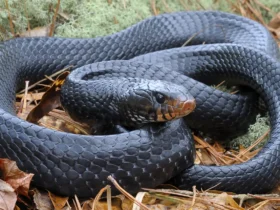The animal kingdom is filled with captivating creatures that have fascinated humans for centuries. Among them, the Striped Coral Snake or Black Coral Snake (Calliophis nigriscens) stands out as a remarkable and mysterious species. With its striking appearance and unique characteristics, this elusive snake has intrigued researchers and nature enthusiasts alike. In this article, we will explore the fascinating world of the Striped Coral Snake, delving into its physical attributes, behavior, and ecological significance.








Appearance and Physical Characteristics
The Striped Coral Snake is a visually stunning creature, characterized by its distinctive black, yellow, and red striped pattern. The bright colors serve as a warning sign to potential predators, as the snake’s venom is highly potent. It possesses a slender body, averaging around 50 to 70 centimeters in length, and its head is relatively small in proportion to its body. The scales of the Striped Coral Snake are smooth and glossy, adding to its allure and elegance.
Habitat and Distribution
This species is predominantly found in Southeast Asia, particularly in countries such as Thailand, Malaysia, and Indonesia. The Striped Coral Snake inhabits various ecosystems, including rainforests, lowland areas, and even agricultural landscapes. It prefers to reside in moist environments, such as leaf litter, decaying logs, and underground burrows. Its adaptability to different habitats has contributed to its wide distribution across the region.
Behavior and Diet
The Striped Coral Snake is a predominantly terrestrial snake, spending most of its time on the forest floor. It is a primarily nocturnal species, venturing out under the cover of darkness to hunt its prey. The diet of the Striped Coral Snake mainly consists of small reptiles, including lizards and other snakes. Its venomous fangs allow it to immobilize its prey swiftly, making it an efficient predator within its ecosystem.
Reproduction and Lifecycle
Like many other snakes, the Striped Coral Snake reproduces through sexual reproduction. Mating typically occurs during the rainy season, and females lay a clutch of eggs after a gestation period of several weeks. The eggs are laid in secluded locations, providing protection from potential predators. After an incubation period of around two months, the hatchlings emerge, equipped with venom from birth. The early stages of life are critical for survival, and the young snakes must quickly develop their hunting skills to secure their sustenance.
Ecological Significance
The Striped Coral Snake plays an essential role in its ecosystem as both a predator and prey. Its diet primarily consists of smaller reptiles, helping to regulate their populations within the ecosystem. At the same time, the snake serves as a valuable food source for larger predators, such as birds and mammals. Additionally, the bright coloration of the Striped Coral Snake serves as a warning to potential predators, contributing to the phenomenon known as aposematic coloration.
Final Thought
The Striped Coral Snake (Calliophis nigriscens) exemplifies the wonders of nature with its mesmerizing appearance and intriguing characteristics. While it remains an enigmatic species, researchers continue to unravel the secrets of this captivating snake. The role it plays within its ecosystem and its unique adaptations highlight the importance of preserving the delicate balance of nature. As we marvel at the beauty of the Striped Coral Snake, let us also remember the broader significance of biodiversity and the need to protect these extraordinary creatures for generations to come.








